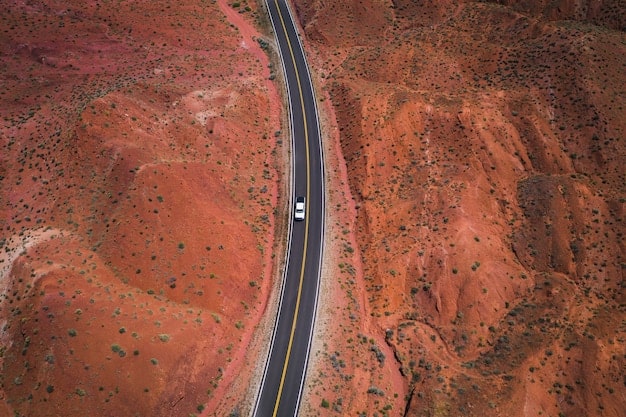How to Plan a Multi-State US Road Trip: Your 2025 Guide

Navigating the complexities of a multi-state US road trip requires meticulous planning, from route selection and budget allocation to vehicle preparation and contingency strategies, ensuring a seamless and memorable adventure in 2025.
Embarking on a multi-state US road trip is often the quintessential American adventure, offering unparalleled freedom and discovery. Whether you dream of tracing historic routes or carving new paths through diverse landscapes, a successful journey hinges on meticulous preparation. This guide will walk you through How to Plan a Multi-State US Road Trip: A Step-by-Step Guide for 2025, ensuring your escapade is as smooth as it is memorable.
Defining Your Multi-State US Road Trip Vision
Before any wheels touch pavement, the foundation of your multi-state road trip lies in clarifying your vision. What kind of experience are you seeking? The vastness of the United States offers a kaleidoscope of possibilities, from rugged national parks to bustling cityscapes, serene coastal drives to historic trails. This initial brainstorming phase is crucial for setting the tone and scope of your adventure.
Identifying Your Interests and Goals
Consider what truly excites you. Are you an outdoor enthusiast yearning for hiking and nature? A history buff eager to explore national monuments? Or perhaps a foodie looking to sample regional cuisines? Your interests will naturally guide your route selection, ensuring the journey aligns with your passions. Discussing these preferences with travel companions is vital to ensure everyone’s expectations are managed and met.
- 🏔️ National Parks & Scenic Beauty: Prioritize routes through iconic parks like Yellowstone, Zion, or the Grand Canyon.
- 🏛️ Historical & Cultural Sites: Explore cities like Boston or Philadelphia, or follow the Lewis and Clark Trail.
- 🏖️ Coastal Drives: Consider California’s Highway 1 or the scenic routes along the East Coast.
- 🏙️ Urban Exploration: Plan stops in major cities for diverse experiences in food, art, and entertainment.
Establishing Your Trip Duration and Season
The length of your trip directly impacts how many states you can realistically cover and the depth of your exploration. A two-week trip will vastly differ from a month-long excursion. Equally important is the season you choose. Peak seasons might mean more crowds and higher prices, but also ideal weather for certain activities. Off-peak travel can offer solitude and savings, albeit with potential weather challenges. Weigh these factors carefully to optimize your experience, considering weather patterns across different states.
For instance, planning a trip to the Southwest in summer might involve extreme heat, while a winter trip through the Rockies demands preparation for snow and ice. Each season presents unique opportunities and challenges that must be factored into your decision-making process.
The core of a successful multi-state road trip begins with a clear, shared vision. By articulating your interests, setting a realistic duration, and choosing the optimal season, you lay the groundwork for an itinerary that truly resonates with your travel aspirations.
Crafting Your Ideal Multi-State Itinerary
With your vision firmly established, the next crucial step is translating it into a concrete itinerary. This phase involves meticulous research, balancing ambitious plans with practical considerations, and plotting a route that maximizes your experience while minimizing logistical hurdles. Effective itinerary planning is the backbone of any successful multi-state road trip.
Researching Potential Routes and Destinations
Begin by mapping out the states and specific attractions that pique your interest. Utilize online tools such as Google Maps, Roadtrippers, or AAA trip planners to visualize routes and estimate driving times. Don’t underestimate the time it takes to travel between destinations; scenic routes often add significant time compared to direct highways. Look for logical geographical groupings of attractions to avoid excessive back-and-forth travel. Consider iconic road trip routes like Route 66 or the Pacific Coast Highway as starting points, then customize them to fit your unique interests.
Remember that the journey is just as important as the destinations. Factor in time for spontaneous detours, roadside attractions, and simply enjoying the changing scenery. Over-scheduling can lead to burnout, so leave room for flexibility. Researching local events or festivals happening during your travel dates can also add an unexpected layer of enjoyment to your trip.
Allocating Time for Stops and Activities
A common pitfall in road trip planning is underestimating the time needed for stops. While a driving day might seem straightforward, factor in meal breaks, fuel stops, stretching, and most importantly, time to explore your chosen destinations. A general rule of thumb is to allow at least half a day, if not a full day or more, for significant attractions like national parks or major museums. For example, a visit to the Grand Canyon truly warrants an overnight stay to experience both sunrise and sunset.
When planning, distinguish between “driving days” and “exploration days.” Build in downtime to avoid fatigue and ensure you’re truly enjoying the experience, rather than just ticking off boxes. This strategy prevents the trip from feeling rushed and allows for deeper engagement with each location. For instance, a major city might easily require two to three days to genuinely explore its main attractions.
Structuring your itinerary meticulously, from the broad strokes of your route to the granular details of time allocation at each stop, ensures a well-paced and enjoyable multi-state adventure. This careful planning prevents exhaustion and maximizes your enjoyment of every moment on the road.
Budgeting for Your Multi-State Adventure
A well-structured budget is paramount for a stress-free multi-state road trip. Anticipating and allocating funds across various categories will prevent unexpected financial strain and allow you to fully enjoy your journey. This financial roadmap empowers you to make informed decisions and ensure your trip remains within comfortable limits.

Estimating Major Expenses: Fuel, Accommodation, Food
Fuel will likely be one of your largest variable expenses. Research average gas prices in the states you plan to visit and use online calculators to estimate total fuel costs based on your projected mileage and vehicle’s fuel efficiency. For accommodation, consider a mix of options: campgrounds, budget motels, mid-range hotels, or even unique Airbnbs. Booking in advance, especially in popular areas or during peak season, can often secure better rates. Food costs can fluctuate wildly based on your habits; cooking some meals at campgrounds or lodging with kitchens can significantly reduce expenses compared to dining out for every meal. Don’t forget snacks and drinks for the road.
- ⛽ Fuel: Calculate based on estimated mileage and current gas prices (use apps like GasBuddy).
- 🏨 Accommodation: Research lodging options (hotels, motels, campgrounds, vacation rentals) and book early for best rates.
- 🍽️ Food: Plan for a mix of dining out and self-catering to manage costs effectively.
Accounting for Activities, Souvenirs, and Contingencies
Beyond the basics, factor in the cost of attractions like national park passes, museum entry fees, or tickets to shows. Set aside a separate budget for souvenirs and unexpected indulgences. Perhaps most critically, allocate a contingency fund. This buffer should be at least 10-15% of your total estimated budget to cover unforeseen circumstances such as vehicle repairs, medical emergencies, or unexpected lodging needs. Having this safety net provides peace of mind and reduces stress if plans go awry.
Creating a detailed spreadsheet or using a budgeting app can streamline this process, allowing you to track expenses in real-time. This proactive approach ensures you stay on track financially, making adjustments as needed during your trip. Remember to factor in parking fees, tolls, and any other minor, recurring costs that can add up over time.
A comprehensive budget serves as your financial compass, guiding your spending decisions throughout the trip. By meticulously forecasting and allocating funds for all potential expenditures, you create a solid financial foundation for an enjoyable and worry-free multi-state road trip experience.
Vehicle Preparedness and Safety Measures
Your vehicle is the lifeline of your road trip, and ensuring its optimal condition is non-negotiable. Thorough pre-trip maintenance and understanding essential safety measures are critical for a smooth journey, especially when covering vast distances across multiple states. A breakdown far from home can be a major setback, both financially and logistically.
Pre-Trip Vehicle Inspection and Maintenance
Before hitting the road, schedule a comprehensive vehicle inspection with a trusted mechanic. This should include checking tire pressure and tread depth, oil and fluid levels (engine oil, brake fluid, coolant, power steering fluid, windshield wiper fluid), brakes, battery health, and all lights. Ensure your spare tire is properly inflated and your jack and lug wrench are accessible and in working order. If your tires are nearing the end of their lifespan, replace them before departure. Packing an emergency kit is also crucial; this should include jumper cables, a first-aid kit, a flashlight, spare batteries, basic tools, reflective triangles, and a rain poncho.
Consider the age and mileage of your vehicle. If it’s older or has high mileage, a more thorough inspection might be necessary. Address any known issues, no matter how minor they seem, to prevent them from escalating into major problems on the road. A well-maintained vehicle is your best defense against unexpected breakdowns.
Essential Safety Tips and Emergency Protocols
Beyond vehicle readiness, personal safety is paramount. Always inform someone of your itinerary, especially when venturing into remote areas. Drive defensively, obey speed limits, and take regular breaks to combat fatigue. Avoid driving drowsy; pulling over for a short nap or switching drivers can prevent accidents. Keep your phone charged and carry a portable power bank. Familiarize yourself with emergency services numbers in the states you’ll be visiting, though 911 is universally recognized. In case of a breakdown, stay with your vehicle, especially in remote locations, and make yourself visible to passing traffic. Having roadside assistance coverage (like AAA) is highly recommended for peace of mind.
- 😴 Avoid Drowsy Driving: Take frequent breaks, share driving duties, and get adequate sleep.
- 📞 Emergency Contacts: Program essential numbers (roadside assistance, family) into your phone.
- 🚨 Preparedness Kit: Carry a stocked emergency kit including first-aid, tools, and reflective gear.
- 🗺️ Share Your Itinerary: Let someone know your route and expected check-in times.
Prioritizing vehicle preparedness and adhering to safety protocols are the cornerstones of a successful and secure multi-state road trip. These measures transform potential anxieties into confidence, allowing you to focus on the joys of your adventure.
Packing Smart for Diverse Climates and Activities
Packing for a multi-state US road trip presents a unique challenge due to the vast geographical and climatic diversity across the country. Strategic packing ensures you have what you need for every scenario, without overpacking and cluttering your vehicle. The goal is efficiency and adaptability.
Versatile Clothing and Layering Systems
The key to packing for varying climates is versatile clothing and layering. Instead of packing separate wardrobes for hot deserts, cool mountains, and temperate coastal regions, focus on pieces that can be mixed and matched. Think moisture-wicking shirts, quick-dry pants, and a sturdy, lightweight jacket that can be worn in different conditions. Layers allow you to easily adapt to fluctuating temperatures throughout the day and across different states. Pack items that can serve multiple purposes, like a bandana that can be a headband, neck warmer, or makeshift eye mask.
Consider the activities you’ve planned. If hiking is on the agenda, appropriate footwear is essential. Similarly, if swimming is a possibility, don’t forget swimwear. Rolling clothes rather than folding can save space, and packing cubes are excellent for organization within your luggage. Limit yourself to one or two bags per person to maintain order in the vehicle.
Essential Gear and Digital Necessities
Beyond clothing, several essential items will enhance your road trip experience. A physical map or atlas, especially for areas with spotty cell service, is a smart backup to your GPS. Portable phone chargers and car chargers are indispensable. A good quality cooler can save money on drinks and snacks. Don’t forget reusable water bottles, sunscreen, insect repellent, and any personal medications. For entertainment, download podcasts, audiobooks, and playlists beforehand. A camera, whether a dedicated one or your smartphone, is crucial for capturing memories. Pack a small kit with basic toiletries and a quick-dry towel.

Remember to consider device charger compatibility. Some older vehicles might lack modern USB ports, necessitating cigarette lighter adapters. A multi-port USB charger can be a game-changer for keeping several devices powered simultaneously. For those who enjoy cooking on the road, a portable camp stove and basic cooking utensils can open up more meal options.
Thoughtful packing is more than just throwing things in a bag; it’s about anticipating needs and preparing for a variety of conditions. By focusing on versatility and essentials, you ensure comfort and readiness for whatever your multi-state adventure throws your way.
Dining on the Road: From Fine Dining to Roadside Delights
Food is an integral part of any travel experience, and a multi-state road trip offers an unparalleled gastronomic journey through America’s diverse culinary landscape. Planning your meals effectively can enrich your adventure, save money, and ensure you remain energized for the road ahead.
Exploring Local Flavors and Unique Eateries
One of the joys of a road trip is the opportunity to sample regional specialties. Research local diners, food trucks, and family-owned restaurants that offer authentic flavors. Don’t be afraid to venture off the main highway for hidden gems. Use apps like Yelp or TripAdvisor to find highly-rated spots known for their local cuisine. From Texan BBQ to New England clam chowder, Pacific Northwest seafood to Southwest green chile, each state offers a distinct taste. Supporting local businesses through your dining choices also adds to the community experience.
Consider incorporating food-related activities into your itinerary, such as visiting farmers’ markets, attending a food festival, or taking a cooking class if time permits. These experiences can deepen your understanding and appreciation of the local culture. Ask locals for recommendations; they often know the best, most authentic places to eat that tourists might miss.
Balancing Restaurant Meals with Groceries and Snacks
While indulging in local fare is exciting, dining out for every meal can quickly deplete your budget. Balance restaurant visits with self-prepared meals and snacks. Pack a cooler with drinks, fruits, sandwiches, and other easy-to-eat items to avoid expensive impulse buys at gas stations. Lodgings with kitchenettes or access to grills at campgrounds can significantly reduce food costs and offer healthier options. Stock up on non-perishable snacks like nuts, granola bars, and dried fruit to keep energy levels up between stops.
- 🍝 Local Restaurants: Research authentic eateries and regional specialties.
- 🍎 Groceries: Stock up on snacks, drinks, and ingredients for self-prepared meals.
- 🥤 Hydration: Carry reusable water bottles and stay hydrated, especially during long drives.
Bringing a portable coffee maker or instant coffee can also save money and time on morning stops. Staying hydrated is also crucial, especially with long hours of driving; make sure to drink plenty of water throughout the day. By strategically planning your meals, you can savor the culinary delights of your multi-state road trip without compromising your budget or energy levels.
Navigating the Open Road: Logistics and Technology
Efficient navigation and smart use of technology are crucial for a seamless multi-state road trip. While the romance of the open road is appealing, practical considerations like refueling, staying connected, and dealing with potential detours are part of the journey. Planning for these logistics ensures a smoother, more enjoyable experience.
Fueling Strategies and Rest Stops
Long stretches of highway, especially in less populated areas, can mean limited fuel stations. Plan your refueling stops, particularly when venturing into rural states or national parks. Don’t wait until your tank is nearly empty; aim to refuel when it’s around a quarter full. Apps like GasBuddy can help you find the cheapest gas prices along your route. Identify rest stops or welcome centers for breaks, as these often have clean restrooms, vending machines, and sometimes even tourist information. Knowing where these amenities are located can alleviate concerns about comfort during long drives.
Consider the type of vehicle you’re driving. If it runs on diesel or requires premium fuel, finding compatible stations might be more challenging in certain regions. Mapping out specific gas stations, particularly in areas with long stretches between towns, can be an effective strategy to avoid unexpected empty tanks.
Leveraging Technology for a Smoother Trip
Modern technology has revolutionized road trips. GPS apps (Google Maps, Waze) are indispensable for real-time traffic updates, alternative routes, and estimated arrival times. Download offline maps for areas with poor cell service. Entertainment apps for music, podcasts, and audiobooks are essential for long stretches. Communication apps keep you connected, but remember that some remote areas will have no signal. Invest in a reliable phone mount for easy navigation viewing and a multi-port car charger to keep all devices powered. Consider a portable Wi-Fi hotspot if constant internet access is critical for remote work or entertainment for passengers.
While technology is a great aid, don’t solely rely on it. A physical map or a printed route can be invaluable if your devices fail or lose signal. Keep paper copies of important reservation confirmations and emergency contacts. Also, ensure your car’s USB ports or cigarette lighter outlets are functioning correctly for charging.
Mastering the logistics of fueling and leveraging technology intelligently transforms potentially stressful situations into manageable aspects of your journey. This proactive approach allows you to focus on the exploration and enjoyment of your multi-state road trip without unnecessary interruptions.
| Key Aspect | Brief Description |
|---|---|
| 🎯 Define Vision | Clarify interests, duration, and ideal season for your trip. |
| ✏️ Itinerary & Route | Research routes, allocate time realistically for stops and driving. |
| 💰 Budget Planning | Estimate fuel, lodging, food, activities, and include a contingency fund. |
| 🚗 Vehicle Prep | Conduct full vehicle inspection and prepare an emergency kit. |
Frequently Asked Questions About Multi-State US Road Trips
▼
The ideal duration significantly depends on how many states and attractions you wish to visit. For covering two to three major regions comfortably, most experts recommend at least two to three weeks. This allows for ample driving time, exploration, and rest without feeling rushed. Shorter trips might limit the number of states you can genuinely experience.
▼
To save on lodging, consider a mix of options. Camping in national or state parks is often the cheapest, followed by budget motels or staying in vacation rentals with kitchenettes for self-catering meals. Booking well in advance, especially outside peak season, can also secure better rates. Look for discounts or loyalty programs if you frequent specific hotel chains.
▼
No, a standard valid driver’s license from any US state is sufficient for driving across all other US states. You won’t need any special permits or licenses for multi-state travel within the United States. Ensure your license is current and not expired, as driving with an expired license is illegal and can lead to fines.
▼
Always carry your valid driver’s license, vehicle registration, and proof of auto insurance. It’s also wise to have copies of important reservations (lodging, activities) and emergency contact information. While not always necessary, having your passport or a secondary form of ID can be useful for certain checks or unexpected situations when traveling near borders.
▼
Having a roadside assistance plan (like AAA or through your auto insurance) is highly recommended. Carry a well-stocked emergency kit including jumper cables, a first-aid kit, and basic tools. Know how to change a flat tire. In case of a breakdown, pull over to a safe location, turn on your hazard lights, and contact your roadside assistance provider.
Conclusion
Planning a multi-state US road trip for 2025 is an intricate but incredibly rewarding endeavor. By meticulously addressing each step—from defining your vision and crafting a detailed itinerary to budgeting wisely, preparing your vehicle, packing smartly, and navigating logistics—you lay the groundwork for an unforgettable adventure. The open road offers endless possibilities for discovery and personal growth, and with careful preparation, you can confidently embark on a journey that truly reflects your aspirations. May your travels be filled with stunning landscapes, memorable encounters, and the joy of American exploration.





